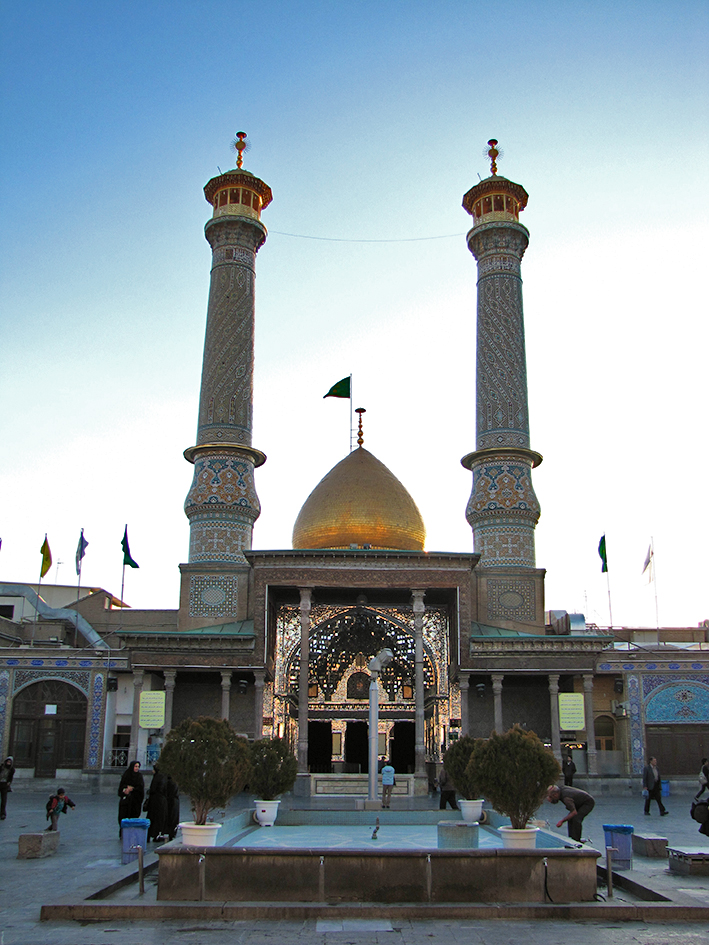Seyed Hashem Moosavi
Introduction
In linguistic terms, “Ziyarat” (visitation) means to visit and to incline towards. At the root of this word lies the concept of attraction and movement. In Shia culture and terminology, Ziyarat refers to a spiritual movement whose primary goal is to achieve an inner connection with the divinely appointed saints (Awliya Allah) and, ultimately, to reach the proximity of God Almighty.
Within Shia tradition, Ziyarat is not merely an individual act of worship; it is a social, identity-forming, and cultural phenomenon that has historically played a crucial role in preserving the cohesion of the Shia community.
A prominent example of this beloved tradition is the Ziyarat of Hadhrat Abdul Adhim Al-Hasani (AS) in the city of Rayy. Through his migration to this city and the emphasis placed by the Infallible Imams (AS) on the immense virtue of visiting his grave, he became one of the Shia Muslims’ central social and spiritual axes.
The central question of this article is: What social and cultural functions has the Ziyarat of Hadhrat Abdul Adhim served for the Shia community, both in the past and today?
The Status of Hadhrat Abdul Adhim in the Words of the Imams (AS)
Hadhrat Abdul Adhim Al-Hasani (AS), a descendant of Imam Hasan Al-Mujtaba (AS), lived during the time of four Infallible Imams: Imam Musa al-Kadhim, Imam Ali al-Ridha, Imam Muhammad al-Jawad, and Imam Ali al-Hadi (AS). His scholarly and spiritual stature was so eminent that Imam al-Hadi (AS) referred some of his followers, including Hammad al-Razi, to him for resolving religious matters, stating« إذا أشكَلَ عَلَيكَ شَىءٌ مِن أمرِ دينِكَ بِناحِيَتِكَ ، فَسَلْ عَن عَبدِ العَظيمِ بنِ عَبدِاللّه الحَسَنِيِّ؛ “If an issue concerning your religion arises in your locality, consult Abdul Adhim bin Abdullah Al-Hasani.” (Majlisi, Bihar al-Anwar, Vol. 69, p. 2)
This endorsement not only provided a theological foundation for the Shia but also solidified public trust in his character and scholarly standing.
Furthermore, when Hadhrat Abdul Adhim presented his beliefs to Imam al-Hadi (AS) in an assembly, the Imam (AS) confirmed him, saying: «یا أباالقاسم، هذا واللّه دین اللّه الذی ارتضاه لعباده “O Abal-Qasim, by God, this is indeed the religion of God which He has approved for His servants.”
He then prayed for him: «ثبتک اللّه بالقول الثابت فی الحیاة الدنیا و فی الآخرة؛ “May God fortify you with the firm word in this worldly life and in the Hereafter!”
Finally, he said about him: «مرحبا يا أبَاالقاسِمِ أنتَ وَلِيُّنا حَقا؛ “Well done, O Abal-Qasim! You are truly our faithful friend (Wali).”
This brief statement indicates his special status near the Ahl al-Bayt (AS) and serves as a criterion for genuine adherence to Wilayah (divinely appointed guardianship). (Shaykh Saduq, Amali, p. 419)
The Virtue of Ziyarat to Hadhrat Abdul Adhim Al-Hasani (AS)
Hadith sources recount that Imam al-Hadi (AS) said to a man from Rayy who had visited the shrine of Imam Husayn (AS): :« أما إنَّكَ لَو زُرتَ قَبرَ عَبدِالعَظيم عِندَكمُ لَكُنتَ كَمَن زارَ الحُسَينَ عليه السلام؛ “If you were to visit the grave of Abdul Adhim near you, it would be as if you have visited Imam Husayn (AS).” (Ibn Qulawayh, Kamil al-Dhiyarat, p. 324)
This narration does not merely express the individual virtue of a Ziyarat; it carries a social message: during a period when visiting Imam Husayn (AS) in Karbala faced political restrictions from the Abbasids, the emphasis on visiting Hadhrat Abdul Adhim provided a legitimate and feasible alternative for sustaining the tradition of Ziyarat and maintaining the cohesion of the Shia community (Muhammad Jafar Tabataba’i, Shi’ism in the Abbasid Era, p. 432). In essence, the Ziyarat of Hadhrat Abdul Adhim served as a “cultural substitute”-a replacement that kept the Shia identity alive and preserved the believers’ connection to the axis of Wilayah.
Cultural and Social Functions of the Ziyarat of Hadhrat Abdul Adhim (AS)
- Fostering Religious Identity and Strengthening Social Cohesion
In an environment where the Abbasid caliphate sought to weaken Shia identity, gathering at and visiting the grave of Hadhrat Abdul Adhim, as a collective ritual, strengthened the social solidarity of the Shia. It allowed them to redefine their religious and Wilayah-based identity. This cohesion functioned similarly to the “Gathering of Arafat”; meaning, the believers, by being present in a sacred space, developed a sense of belonging to a religious community larger than themselves.
- Cultural Resistance
The Dhiyarat of Hadhrat Abdul Adhim was a form of soft resistance against the official policies of the Abbasids. When the Abbasids restricted travel to Karbala, the Shia, by visiting the grave of Hadhrat Abdul Adhim in Rayy, sent a message of their continued loyalty to the Ahl al-Bayt (AS). This is what some social scientists term “everyday cultural resistance” (James C. Scott, Domination and the Arts of Resistance: Hidden Transcripts, p. 245).
Everyday cultural resistance, in a theory one might call “popular creativity,” refers to a set of small, intelligent, and informal actions in daily life employed by individuals and social groups to stand against cultural and political domination and safeguard their identity and cultural autonomy. These resistances, often invisible and subtle, include cultural, social, and symbolic activities such as specific Ziyarat, using local language, specific dress codes, different customs, and artistic and religious activities that help preserve distinction and group identity against the dominant culture.
This concept shows that even under pressure, individuals are not merely passive victims. Rather, by utilizing their initiative and cultural-social agency, they resist domination in creative ways and protect their identity. The visitation of the graves of divine saints, including Hadhrat Abdul Adhim Al-Hasani during the oppression and threats of the Abbasid era, is an intelligent example of this soft resistance, which was guided by Imam al-Hadi (AS).
- Transmission of Religious Teachings
The repeated emphasis of the Infallible Imams (AS) on visiting the shrine of Hadhrat Abdul Adhim Al-Hasani (AS) meant that from its inception, this site was not limited to being merely a spiritual sanctuary. It gradually evolved into a centre for education, research, and the exchange of Shia knowledge. This scholarly role was strengthened to such an extent that the city of Rayy became one of the main centres for Shia gathering and a crucial base for their scientific and educational activities, prompting numerous prominent scholars, traditionists, and jurists from other cities to migrate to Rayy. Key figures of this scholarly hub include Al-Kulayni, Shaykh Saduq, Ibn Qubah al-Razi, and Abul Futuh al-Razi.
Historical sources attest that during the 4th and 5th centuries AH (Hijri), Rayy was counted among the important centers of Shia scholarship, and the shrine of Hadhrat Abdul Adhim added depth and credibility to this scientific and spiritual standing. This attraction drew major scholars to the city for teaching and scholarly debates; for instance, Allamah Majlisi, in his reports, mentions this shrine as one of the important hubs for scholarly gatherings.
This trend gained further momentum in the last two centuries with the architectural development and establishment of schools and libraries adjacent to the shrine. In the 13th century AH, the religious schools around the shrine became centres for nurturing religious students (tullab), and major study circles, such as those of Mirza Abul Qasim al-Qumi (Sahib al-Qawanin), were held there.
The presence of Mirza al-Qumi in Rayy was not a simple residence but a turning point in strengthening the scientific and educational function of the shrine of Hadhrat Abdul Adhim (AS) during the Qajar era. His teaching near this shrine attracted elite students and transformed it into a reputable and thriving seminary (hawzah ilmiyyah), clearly demonstrating how this sacred mausoleum has historically functioned as a vital scientific and educational base for Shia Muslims, in addition to its devotional and social roles.
In the contemporary era, the shrine of Hadhrat Abdul Adhim continues to serve as a centre for transmitting religious teachings. The presence of students, the holding of religious ceremonies, Quranic sessions, and scholarly lectures have turned this place into a dynamic base for education and the promotion of Islamic knowledge. Today, cultural-religious institutions affiliated with the Astan (custodianship) of Hadhrat Abdul Adhim, such as the “Hadhrat Abdul Adhim Research Institute” and the “Abdul Adhim Encyclopedia,” are active in producing scientific and religious works, showing that the ancient tradition of teaching and learning in the vicinity of this holy shrine is still very much alive.
Conclusion
The Ziyarat of Hadhrat Abdul Adhim Al-Hasani (AS) transcends being an individual act of worship; it is a social and cultural phenomenon that has played an unparalleled role in Shia history. Supported by the emphasis and validation of the Infallible Imams (AS), it became a factor for strengthening Wilayah-based identity, fostering social cohesion, and cultural resistance against the oppressive Abbasid rule. During times of suffocation, this sacred site served as a legitimate substitute for the Ziyarat of Karbala, keeping the connection between the Ummah and the Imamate alive and transforming into a hub for the transmission of the knowledge and teachings of the Ahl al-Bayt (AS). Today, his shrine continues its life as a dynamic base for education, learning, and fostering cohesion within the Shia community, preserving these original functions.






